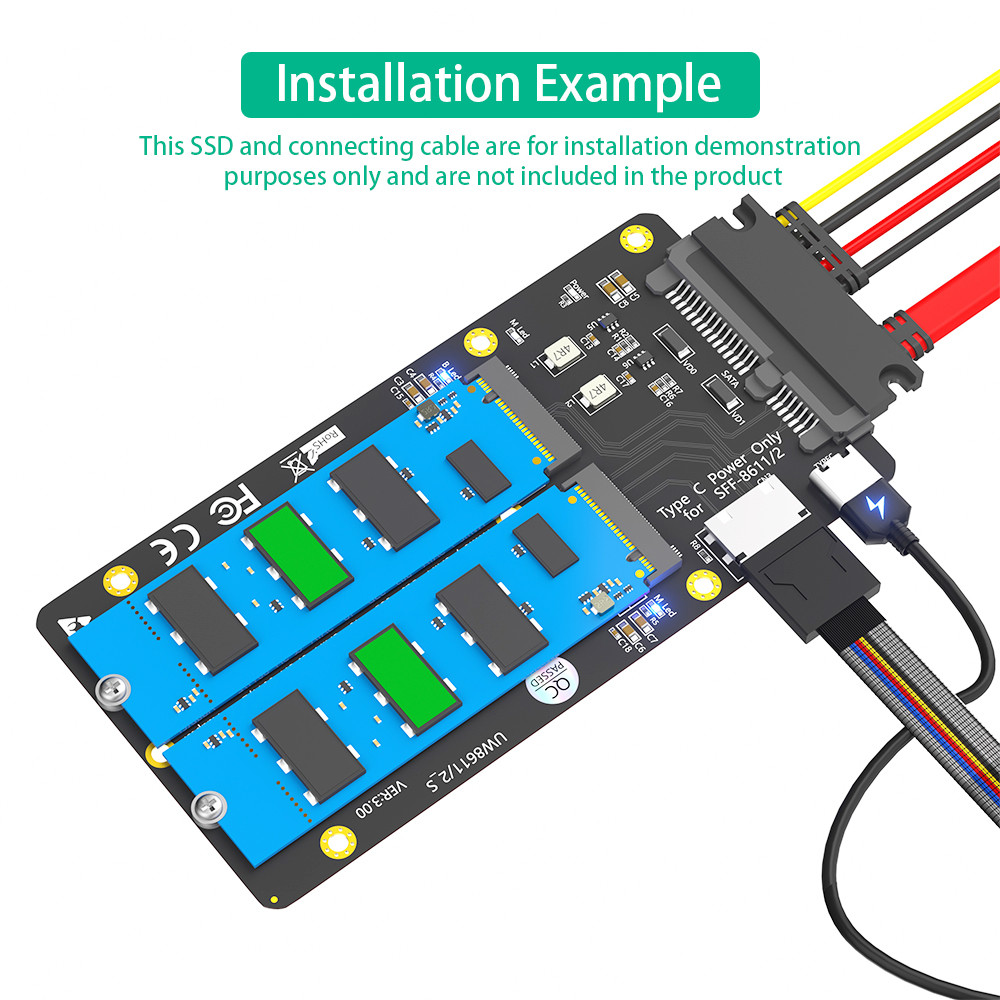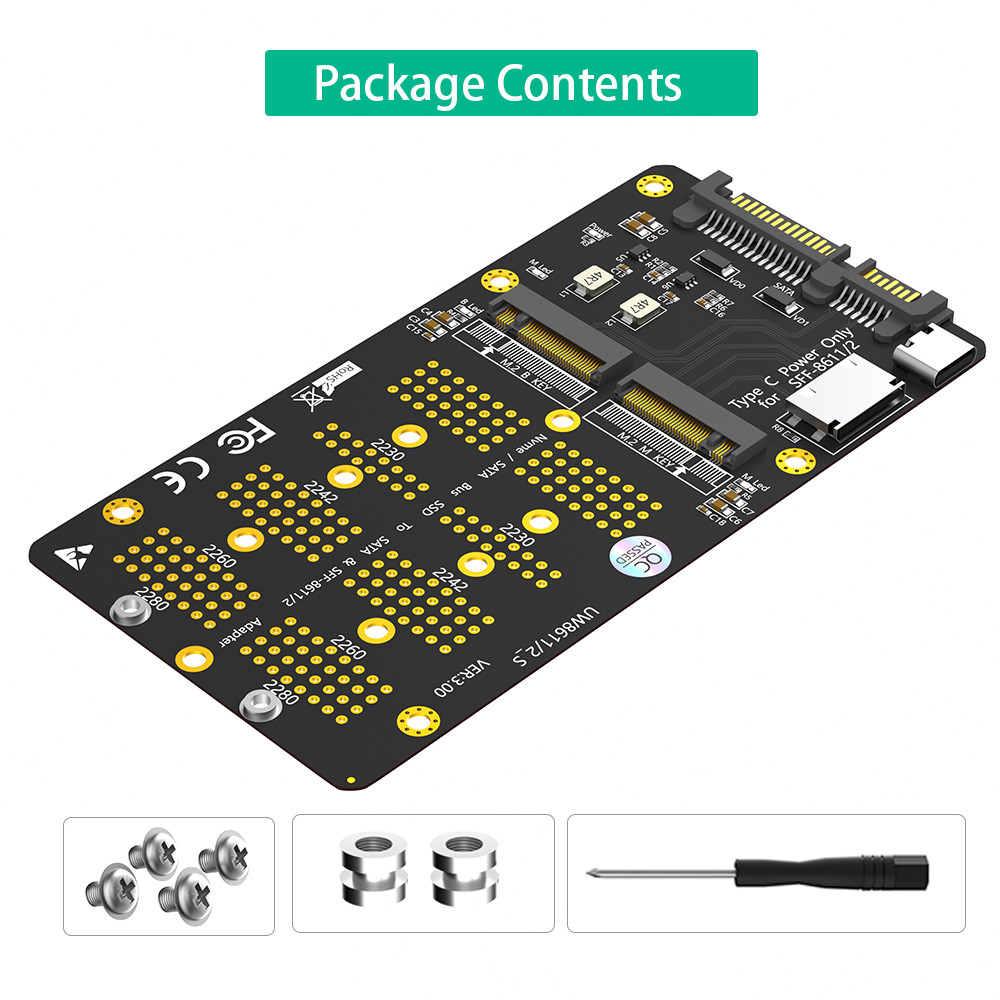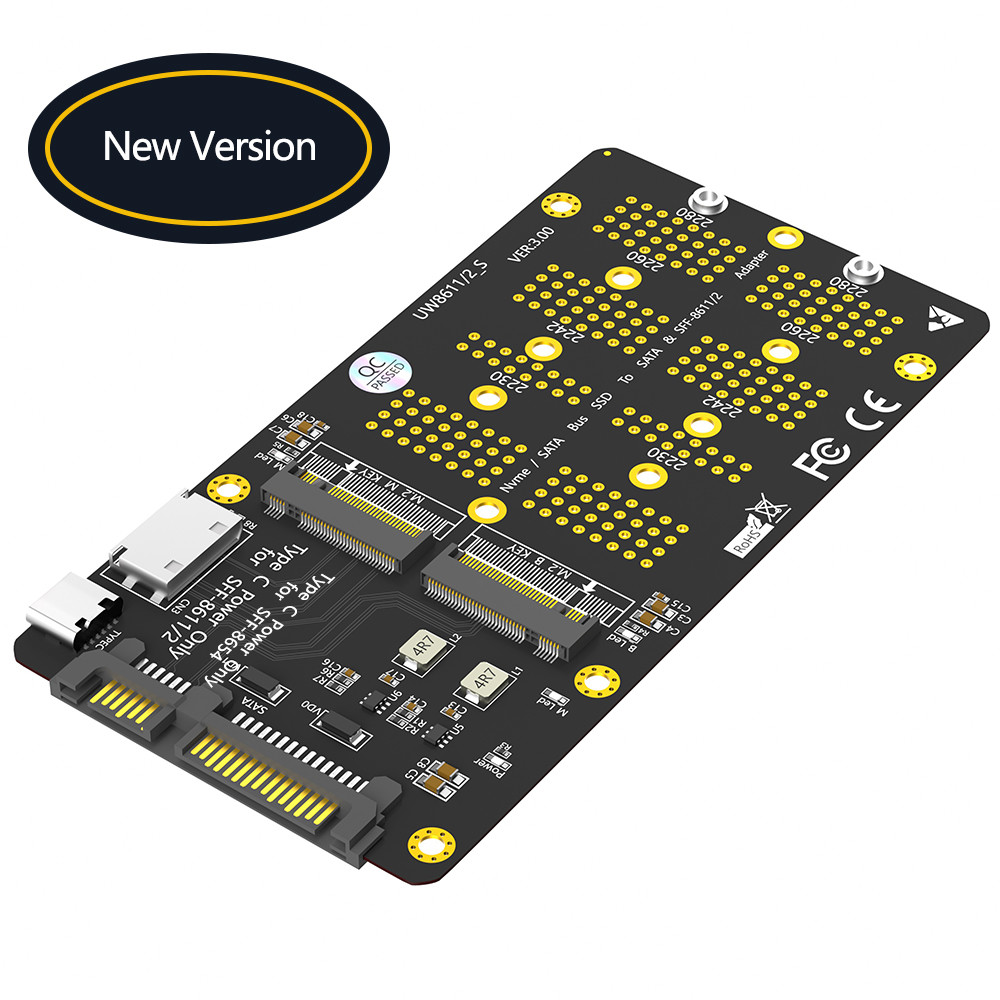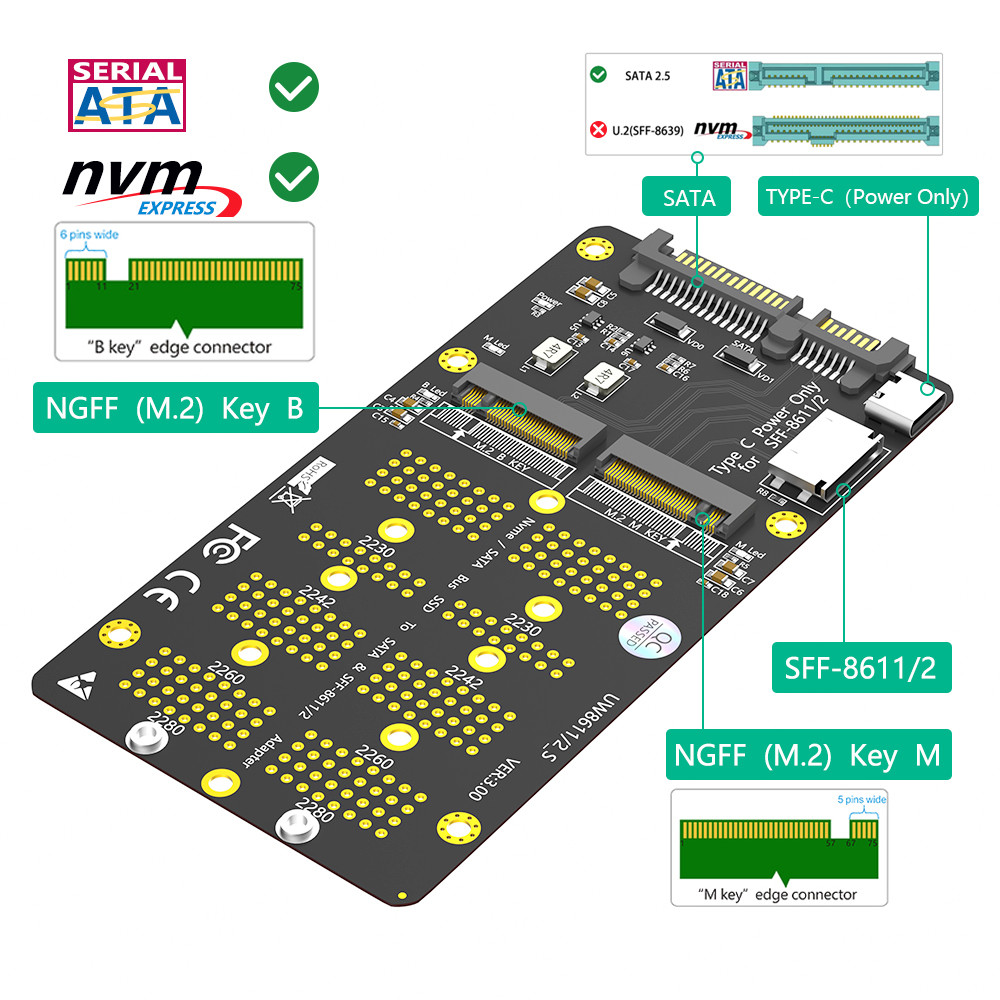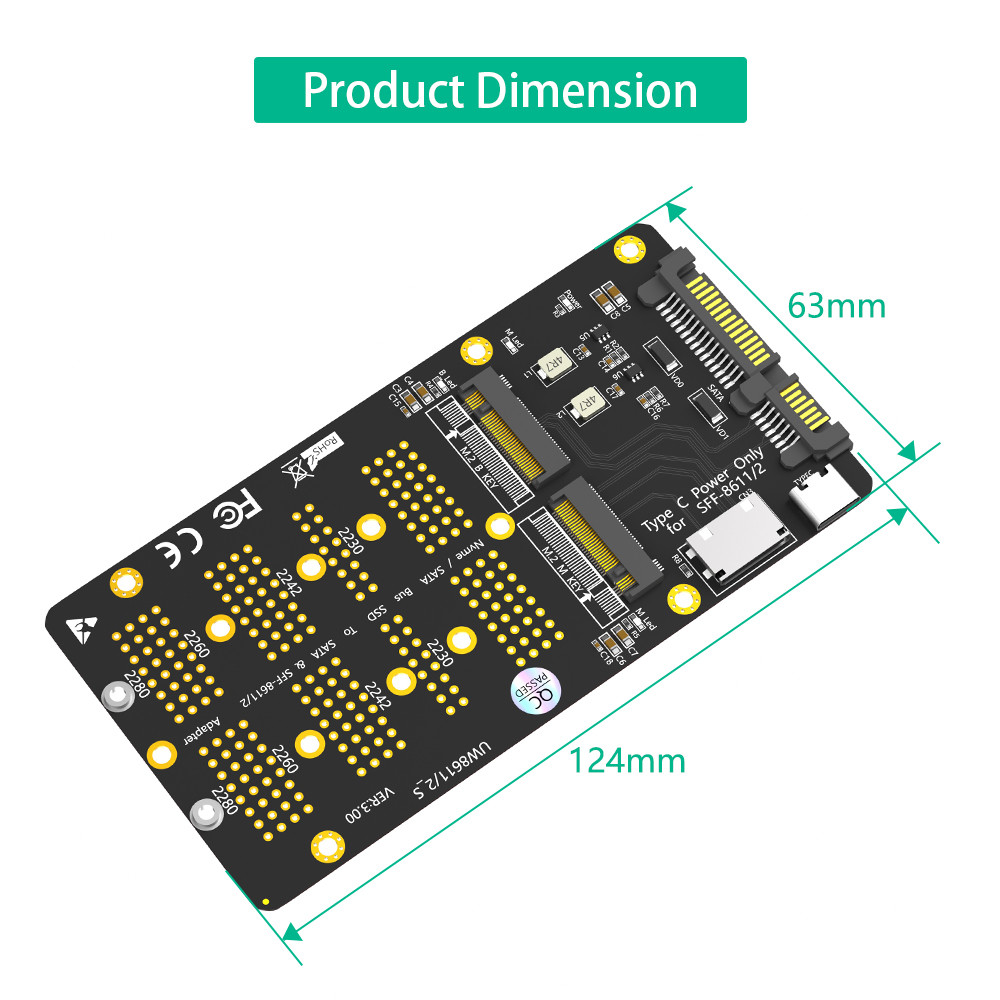New Version 2 In 1 Combo M.2(NGFF) NVMe SSDSATA-Bus SSD To SFF-8654
And SATA Adapter.
Product specifications:
1.Supports M.2 nvme SSD in format 2230, 2242, 2260 and 2280.
2.Support M.2 key B/B+M SATA bus SSD in format 2230, 2242, 2260 and
2280.
3.No drivers needed for this Adapter.
4.Type C interface is only for SFF-8611/8612 power.
5.Type C interface is only for SFF-8611/8612 power.
Product Overview:
This product is a powerful and intricately designed dual SSD
adapter designed to provide users with flexible and diverse
solid-state drive expansion solutions. It integrates two SSD slots
with different protocols, which can adapt to both NGFF (M.2) Key-B
and SATA protocol SSDs, as well as NGFF (M.2) Key-M and NVME
protocol SSDs. It covers a variety of common sizes and smoothly
outputs data from different types of SSDs through precise interface
conversion. It is equipped with TYPE-C auxiliary power supply and
intuitive LED indicator lights, which can meet the needs of
computer upgrades, data storage expansion, and high-performance
computing. It is widely used in desktop computers, laptops, mini
hosts and other devices.
Product features:
1. Dual protocol slots, widely compatible: Two SSD slots have been ingeniously designed. The SSD1 slot is
designed for NGFF (M.2) Key-B SSDs that follow the SATA protocol,
accurately matching their electrical characteristics and physical
specifications. It supports four sizes: 2230mm, 2242mm, 2260mm, and
2280mm, allowing users to find a home for SATA protocol SSDs of
different specifications in their hands; The SSD2 slot is designed
for NGFF (M.2) Key-M SSDs that support the NVME protocol. It is
also compatible with the four sizes mentioned above, fully meeting
the diverse SSD application needs of today. Whether upgrading old
devices or configuring new ones, it can be easily handled, greatly
expanding the product's applicability.
2. Precise interface conversion and high-speed transmission: For the SSD1 slot, the internal circuit is cleverly designed to
accurately convert the data transmission path of NGFF (M.2) Key-B
into the output of the SATA3.0 interface on the adapter, fully
utilizing the high-speed and stable characteristics of the SATA3.0
interface. The theoretical transmission rate can reach 6Gbps,
ensuring fast data read and write, and meeting the storage speed
requirements of daily office, entertainment and other common
application scenarios; The NGFF (M.2) Key-M corresponding to the
SSD2 slot is converted to the SFF-8611/2 interface, perfectly
adapting to the ultra high speed transmission requirements of NVME
protocol SSDs, unleashing their high-performance potential, and
providing strong support for speed demanding scenarios such as
professional data processing and large-scale game loading.
3. TYPE-C auxiliary power supply, stable guarantee: Considering the high power demand of some high-performance SSDs
during operation, a TYPE-C auxiliary power supply interface is
specially equipped for the NGFF (M.2) Key-M slot. This design can
provide additional stable power to SSDs that support NVME protocol
in the case of insufficient power supply to the motherboard,
ensuring stable operation of SSDs, avoiding performance
degradation, disk dropping and other problems caused by unstable
power supply, ensuring the continuity and reliability of data
transmission, especially suitable for high-performance computing
scenarios with strict power supply requirements.
4. LED indicator lights, real-time monitoring: Both slots are equipped with LED indicator lights, like the
"health guard" of SSD, reflecting its working status in real time.
When the SSD is in different stages such as reading and writing
data, initialization, etc., the indicator lights will appear with
corresponding flashing frequency or color changes (depending on the
design), allowing users to intuitively understand the transmission
and usage of the SSD without complex software monitoring. For
example, during data backup and system startup, users can quickly
determine whether the SSD is working properly, discover potential
problems in a timely manner, and safeguard data security.
Product Structure and Interface Introduction
SSD slot:
SSD1 slot (NGFF (M.2) Key-B): strictly built according to the NGFF (M.2) Key-B standard, the
internal dimensions accurately adapt to four sizes of SSDs: 2230mm,
2242mm, 2260mm, and 2280mm. The gold finger contact area adopts a
strong oxidation resistant gold plating process to ensure good
conductivity after long-term use, providing reliable guarantee for
SSD insertion and electrical connection. The slot is equipped with
sturdy and durable buckle devices around it. Through clever
mechanical structure design, when the SSD is inserted into place,
the buckle can automatically lock, ensuring that the SSD is firmly
in the slot and convenient for users to disassemble, providing
convenience and reliability guarantee for frequent SSD insertion
and removal operations.
SSD2 slot (NGFF (M.2) Key-M): Designed according to the NGFF (M.2) Key-M standard, it accurately
adapts to the four sizes of SSDs mentioned above. The interior is
made of high-quality alloy material to create gold finger contact
points, which are finely gold-plated to ensure a tight and stable
connection with the SSD, fully meeting the high-speed and
high-frequency data transmission requirements of NVME protocol
SSDs. The buckle device around the slot is similar to SSD1,
ensuring the stability of the SSD in the slot and facilitating user
operation.
Output interface:
SATA3.0 interface: Designed in accordance with the universal SATA3.0 standard
specifications, its internal pin layout is precise and error free,
and high-quality metal materials are used to create contact points
with excellent conductivity and signal transmission capabilities.
The interface shell is made of metal material and grounded to
effectively block external electromagnetic interference, ensuring
power supply stability and data transmission integrity. When
connecting computer motherboards or other devices, the external
dimensional tolerance of the interface is controlled within a very
small range, ensuring smooth insertion and removal, facilitating
user connection, and laying a solid foundation for high-speed data
transmission between adapters and external devices.
SFF-8611/2 Interface: Designed specifically for adapting to NVME protocol SSDs, the
interface has a precise internal structure and reasonable pin
layout, which can accurately match the high-speed data transmission
requirements after NGFF (M.2) Key-M conversion. The shell is made
of metal material and grounded, with good shielding performance,
ensuring that signal transmission is not affected by external
interference, ensuring that the high performance of NVME protocol
SSD can be fully utilized, and providing reliable interface support
for professional data processing scenarios.
TYPE-C auxiliary power supply interface: Adopting the universal TYPE-C standard, the internal pin layout of
the interface is precise, and the shell is made of metal material
and grounded to effectively block external electromagnetic
interference, ensuring power supply stability and data transmission
integrity. It is compatible with most TYPE-C power cables on the
market, making it convenient for users to connect various external
power sources such as computer USB ports, mobile phone chargers,
etc., providing stable and continuous power input for SSDs that
require additional power.
LED indicator light: High brightness and low-power LED beads are selected, and through
carefully designed internal circuit connections, they are
accurately associated with the read and write status of the SSD.
The lamp beads are packaged with long-life and high stability
materials to ensure reliable illumination during long-term and
frequent use, providing users with continuous and accurate status
indicators to help them quickly determine the working condition of
the SSD.
Performance advantages:
Multi compatibility and flexible expansion: With a dual protocol and multi size compatible SSD slot design,
users can freely combine and configure according to their own needs
and existing SSD resources, easily achieving dual expansion of
storage capacity and performance. Whether it's using idle SATA
protocol SSDs for upgrading old computers or introducing
high-performance NVME protocol SSDs for new installations, there's
no need to worry about compatibility issues, providing a one-stop
solution to meet diverse storage needs and improve overall device
performance.
High speed transmission, soaring efficiency: precise interface conversion corresponding to different slots
fully utilizes the transmission advantages of SATA and NVMe
protocols. The SATA3.0 interface ensures fast reading and writing
of regular data, while the NVME protocol achieves ultra high speed
transmission in professional scenarios, significantly reducing data
transmission time. In scenarios such as large file transfer, system
startup, game loading, etc., compared to traditional single
interface storage solutions, the transfer speed can be increased by
15%, significantly improving work efficiency and user experience.
Stable power supply and performance guarantee: The TYPE-C auxiliary power supply interface provides a solid
support for high-performance NVME protocol SSDs, effectively
solving performance bottlenecks caused by insufficient power
supply. In scenarios such as high load data processing and
long-term continuous reading and writing, ensuring the stable
operation of SSDs, avoiding issues such as disk drops and lagging,
and improving data transmission stability by 15% compared to
situations without auxiliary power supply ensures the safe and
smooth transmission of critical data.
Real time monitoring, worry free: Real time feedback from LED indicator lights allows users to
constantly monitor SSD dynamics. Whether it is file reading and
writing in daily office or continuous transmission in professional
data processing, as long as the status of the LED is observed, it
is possible to timely detect whether there are hidden faults in the
SSD, such as data transmission lag, SSD sleep abnormalities, etc.,
which facilitates taking measures in advance, reduces the risk of
data loss caused by SSD failures, and safeguards data storage.
Usage:
Install SSD: Select the corresponding slot based on the protocol supported by
the SSD. If it is an SSD that supports SATA protocol, gently open
the SSD1 slot buckle, align the SSD golden finger with the slot,
and insert it slowly and steadily, paying attention to the correct
insertion direction to avoid forcefully inserting and causing
damage to the golden finger. Until the SSD is fully inserted and
the buckle automatically locks, ensuring a tight connection between
the SSD and the slot; If it is an SSD that supports the NVME
protocol, insert it into the SSD2 slot in the same way.
Connecting external devices: Connect the SATA3.0 interface of the adapter to the corresponding
interface of the computer motherboard or other devices through a
standard SATA data cable, ensuring that the data cable plug is
tightly connected to the interface, smoothly inserted and removed,
and avoiding loose or virtual connections. For SSDs that support
the NVME protocol, use a dedicated data cable to connect the
SFF-8611/2 interface to the compatible device, ensuring a secure
connection. If necessary, connect the TYPE-C auxiliary power supply
interface, use the TYPE-C power cord to connect one end to the
adapter interface and the other end to a suitable power device,
such as a computer USB interface, phone charger, etc., to ensure
stable power supply.
Observe SSD status: After completing the above installation steps and turning on the
relevant devices, pay attention to the LED indicator status
corresponding to the two slots. Under normal circumstances, during
system startup, file reading and writing, etc., the LED beads will
flash or stay on in a corresponding manner according to the working
condition of the SSD. If there is no response or abnormal flashing
of the LED beads, it may indicate that there is a problem with the
SSD or adapter, and further checks are needed to ensure that the
connection is tight and the SSD is working properly.
Normal use and monitoring: During the normal operation of the device, continuously monitor
the status of the LED beads and the read/write performance of the
SSD, such as whether there are any lagging, delay, or other
phenomena. If any abnormalities are found, they should be promptly
investigated and resolved by checking the connection, restarting
the device, replacing the SSD, etc., to ensure the stable and
efficient operation of the storage system.
Applicable scenarios:
Computer upgrade and renovation: When upgrading storage on old desktop or laptop computers, users
often have SSDs of different types and sizes on hand. This adapter
can integrate and utilize multiple SSDs, whether it is using idle
SATA protocol SSDs to expand ordinary storage or introducing
high-performance NVME protocol SSDs to improve system response
speed, it can be easily achieved without replacing the entire
motherboard or hard drive array, saving costs, improving device
performance, and meeting daily office and entertainment needs.
New installation configuration optimization: For new installation users, different protocols and sizes of SSDs
can be flexibly matched according to budget and performance
requirements. Through this adapter, we can fully leverage the ultra
high speed transmission advantages of NVME protocol SSDs, as well
as the cost-effectiveness of SATA protocol SSDs, to build a
multi-level storage system that meets the requirements of different
application scenarios for storage speed and capacity. For example,
NVME protocol SSDs can be used to quickly load game partitions,
SATA protocol SSDs can be used to save large amounts of data
storage, and the storage configuration of new computers can be
optimized.
Professional data processing: In professional fields such as video editing, big data analysis,
and 3D modeling, there is a high demand for SSD storage speed and
stability. The NVME protocol slot and TYPE-C auxiliary power supply
of this adapter ensure stable operation of high-performance SSDs,
fast reading and writing of massive data, and real-time monitoring
with LED indicator lights to timely detect and solve potential
problems, ensuring that professional workflows are not constrained
by storage bottlenecks and improving work efficiency.
Package contents:
1x M.2 NVMe to PCI-e Adapter.
1x Screw Driver.
4x M2 Sliver screw.
2x standoff.
